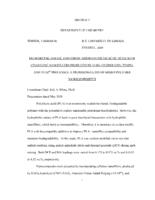- Collection:
- Atlanta University and Clark Atlanta University Theses and Dissertations
- Title:
- Reinforcing maleic anhydride modified poly(lactic acid) with cellulose nanofillers produced by H2So4 hydrolysis, tempo, and AVAP® processes: A promising class of green polymer nanocomposites, 2020
- Creator:
- Sorsor, Varbah H.
- Date of Original:
- 2020-05
- Subject:
- Degrees, Academic
Dissertations, Academic - Location:
- United States, Georgia, Fulton County, Atlanta, 33.749, -84.38798
- Medium:
- theses
- Type:
- Text
- Format:
- application/pdf
- Description:
- Poly(lactic acid) (PLA) is an extensively studied bio-based, biodegradable polymer with the potential to replace unstainable petroleum-based plastics. However, the hydrophobic nature of PLA leads to poor interfacial interactions with hydrophilic nanofillers, which leads to incompatibility. Therefore, it is necessary to surface modify PLA with biocompatible additives to improve PLA - nanofiller compatibility and maintain biodegradability. In this study, PLA was surface-modified via in-situ free radical catalysis, using maleic anhydride (MA) and dicumyl peroxide (DCP) during melt-mixing. Both DCP and MA loadings were varied from 0.172 to 0.972 wt.% and 0.0125 to 4.32 wt.%, respectively. Nanocomposites were prepared by incorporating cellulose nanofillers, produced by H2SO4 hydrolysis (CNCs SAH), American Value-Added Pulping (AVAP®), and 2,2,6,6-tetramethylpiperidine-1-oxyl (CNFs TEMPO) processes, in maleated PLA by high torque melt mixing. The new nanocomposites were characterization by thermogravimetric analysis (TGA), dynamic mechanical analysis (DMA), differential scanning calorimetry (DSC), tensile testing, melt flow index (MFI), and Fourier transforms infrared (FTIR). The incorporation of CNCs by high torque melt mixing in maleated PLA prepared with 0.772 wt.% DCP and 0.0125 wt.% MA were found to give the most promising nanocomposites. The incorporation of 0.5 wt.% CNCs in maleated PLA 0.0125 resulted in a drastic improvement in thermomechanical, rheological, and mechanical properties. In the best case the nanocomposite exhibited a tensile strength of 68 megapascals (MPa) and Young's modulus of a 5.99 Giga pascal (GPa), which represent a 124% and 346% improvement, respectively, as compared to neat PLA. The thermal stability of the nanocomposites was determined using the Kissinger and Ozawa-Flynn-Wall methods (ASTM E 1641-16). The nanocomposites incorporating TEMPO prepared CNFs exhibited the lowest thermal stability. The nanocomposites incorporating SAH produced CNCs were unstable at high temperatures and the nanocomposites incorporating the AVAP prepared CNCs exhibited the highest thermal stability.
- External Identifiers:
- Metadata URL:
- http://hdl.handle.net/20.500.12322/cau.td:2020_sorsor_varbah_h
- Rights Holder:
- Clark Atlanta University
- Holding Institution:
- Atlanta University Center Robert W. Woodruff Library
- Rights:
-
